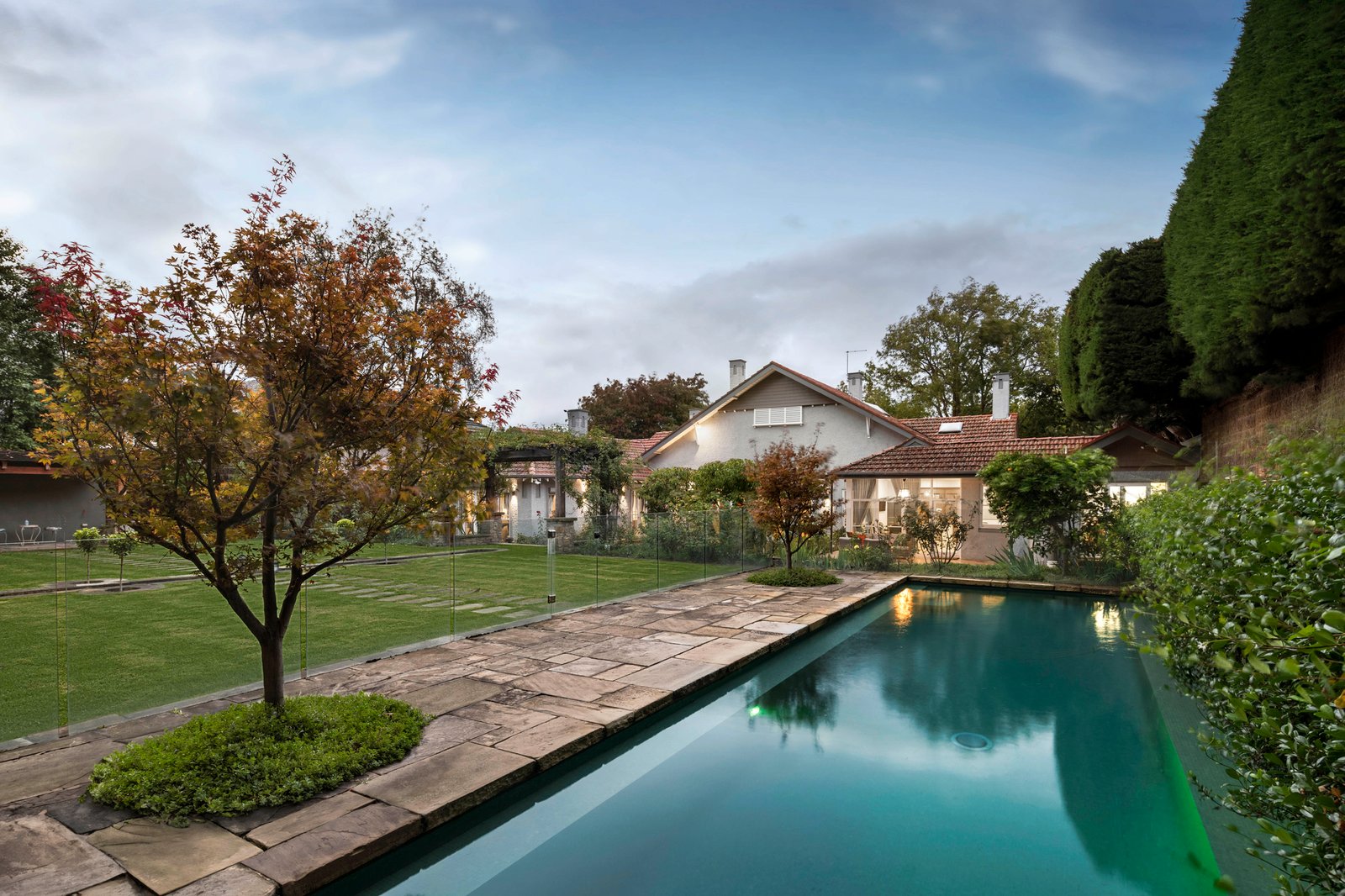The Best Indoor Plants You’ll Ever Grow To Spruce Up Your Home
From the fabulous frilly to desktop companions, these easy care plants will bring your interiors to life
We want plants, we love plants – but which plants will love us back? Here are the top 15 plants that will live happily in your home with the minimal amount of care. Some new wave, some old school, but all worth the effort.
Fruit Salad Monstera

Let’s start with the big guy of indoor plants, the big leafed Monstera. The easiest and least demanding of house plants that will give you the biggest bang for your buck. If you enjoy watching a slow reveal, buy a baby one, and watch as the leaves unfurl, eventually growing as big as 30cm. Bright light is good, but not vital. Water when dry – how easy is that?
Boston Fern
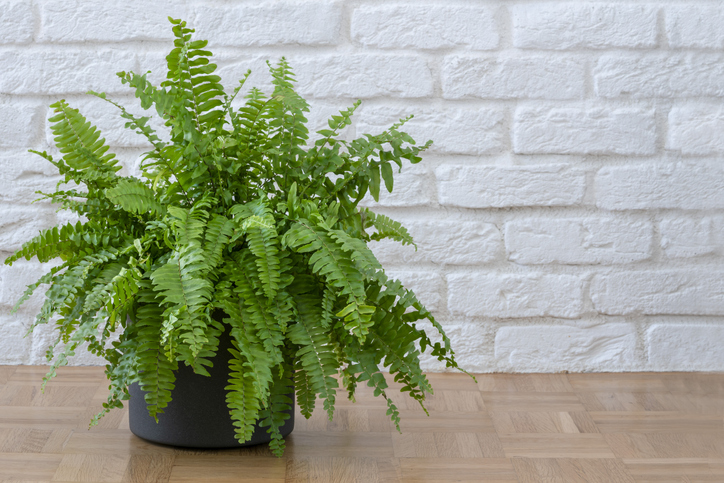
A long loved and robust fern that is coming back into vogue. Either in a stand, or hanging in a basket the ‘sword’ fern does require good watering (so hanging one high might be a pain in the neck), and thrives with a dose of liquid fertiliser, and the occasional spritz of water. They love light, but don’t let them get sunburnt. A super happy one can grow over a metre wide.
Black Velvet

For absolute drama folks are looking to the black velvet plant – which looks especially stunning in a grey pot. It’s all about the leaves, so position in indirect light – but don’t miss out on a spotlight at night. New leaves start out green, and turn ‘black’ as they slowly mature, in direct contrast to white veins. A showpiece plant that can be a bit moody.
Mother-in-Law’s Tongue

Here is a vintage look that is coming back to us. The architectural shape of the stiff and fleshy variegated leaves offer a real statement to any décor. Plus, they are as tough as old boots and can be positioned in any indoor light situation and while they might occasionally sprout a small white flower or two, the metre long leaves are the star attraction.
Rubber tree

For a true mid-century look, you can’t go past a rubber tree, once the décor partner of starburst wall clocks and Parker lounge sets. Position it near a sunny window, and let it dry out between waterings. Pruning will lead to a bushier plant – and off cuts often survive as new plants relatively easily.
Devil’s Ivy
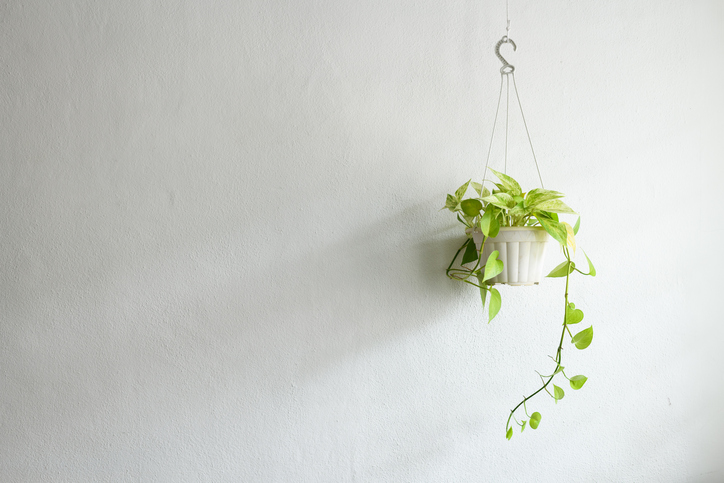
For some reason these plants are always highly priced, when in fact they grow easily from cuttings. Go figure. However, these plants are vines that are born to run, and with little help will do just that, showing off shiny, heart shaped leaves on fleshy stems. The brighter the position, the more verdant the growth – but they can take a little shade. Prune for a bushy response, or even train up a wall trellis.
Peace Lily

With all this leafy talk, it’s nice to look at the virginal white petals of the verdant Peace Lily.
These guys will live for years, despite casual care. No fan of direct sun, but happy to be in a bright spot, they let you know if they’re very thirsty by wilting at the speed of light. Can live for years, and enjoy being repotted – and may be split into two plants (or more) if you’re brave.
Jade Plant
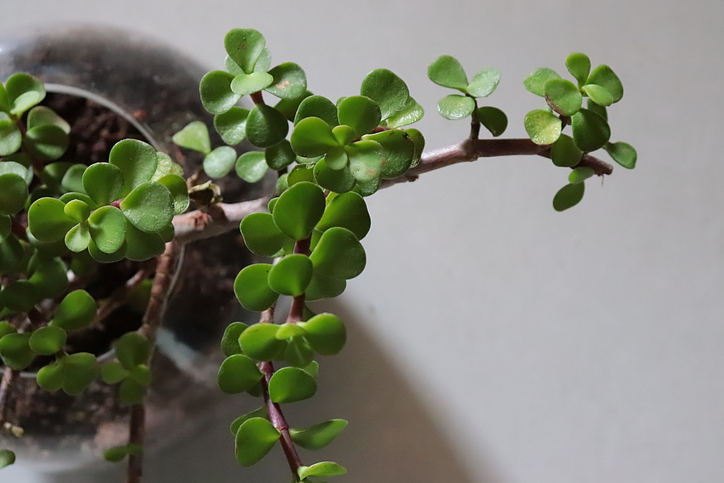
Those chubby little succulent leaves are just the ticket for a hardy indoor plant. They do grow relatively fast, especially when happy. The weak spot is root rot – so do not show your love by overwatering. They are sun loving, and the more the better, and fit happily into a small container – they look 100 per cent better in a contemporary pot with white gravel as mulch. Fun fact: broken off leaves will grow a whole new plant if laid in moist soil.
Blue Star Fern
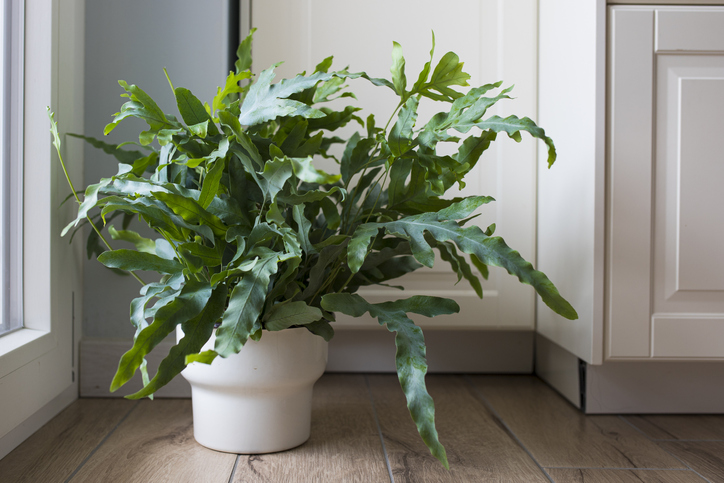
Fabulous muted blue/green fronds in irregular shapes makes this new indoor plant a very cool customer. It’s a goody for the bathroom as it tolerates lowish light and looks divine against white tile. Interestingly it’s an epiphyte and naturally grows on trees in the forest, so a standard potting mix won’t cut it. If you’re repotting, try an orchid mix.
Fiddle Leaf Fig

Is it possible to be sick of a plant? This one has been the poster child for contemporary design for a decade – it’s a good-looking plant when treated well. So many were bought for instant effect and then abandoned like a cold chai latte, they have a bad rep. When thriving you can’t beat their deep green, big, glossy leaves. Fiddles play well with others – so if you can afford it, get a few together so they ‘self humidify’ . Position in lots of bright light, but out of drafts.
Maiden Hair Fern
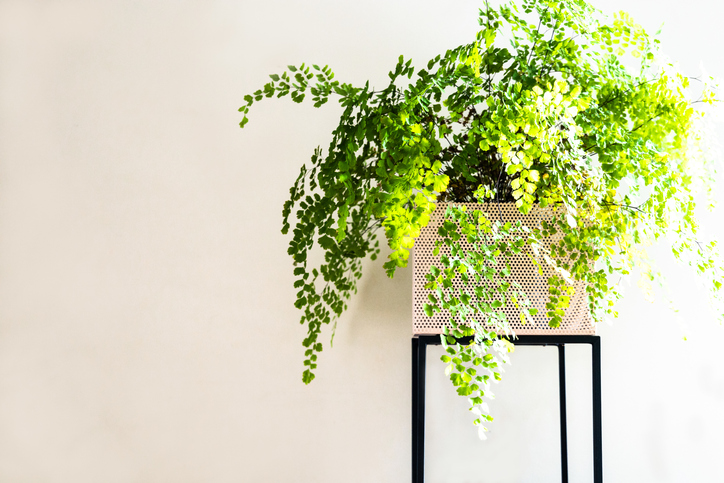
If a plant could be described as a babbling brook, this would be it. Masses of dainty leaflets, cute curly fronds, dense foliage – ideal. Kept away from drafts, out of direct sun, but well humidified (a spritz a day keeps the brown leaves away), they can grow to be, frankly, enormous. And like any true beauty, they look good dressed in any sort of pot. Good news is, if you think you killed it – just cut it back to the ground and put it in the shade – voila! It will come back.
Cyclamen
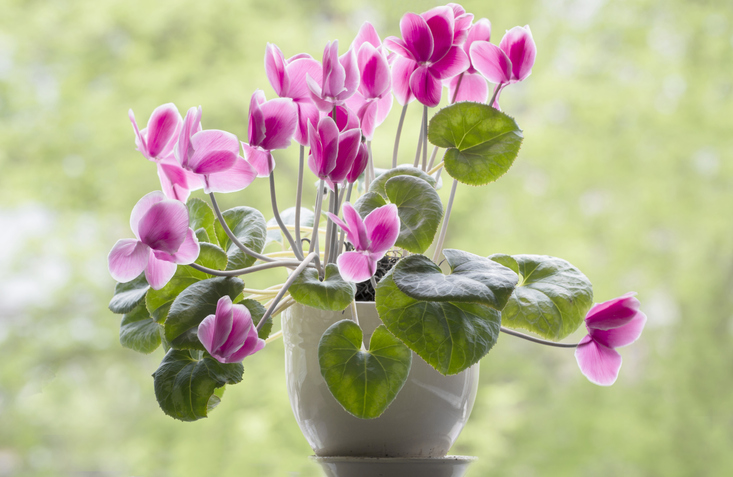
Of all the indoor plants that give a huge performance, you really can’t top the Cyclamen when she’s in bud and bloom. Surrounded by pretty variegated leaves, the sturdy spires pop up in Autumn and winter with masses of flowers. They don’t like being in a hot room, and prefer being watered by drawing water from a shallow tray. They don’t last forever, but they give it heaps while they’re here.
Basil

Yes, the fragrant and tasty basil can thrive on a sunny window sill, and you get to show off by snipping the odd leaf and adding it to your focaccia – or if things are going really well, your own pesto. It grows like mad, and needs to be kept moist but after that, she’ll just keep on giving.
Moss
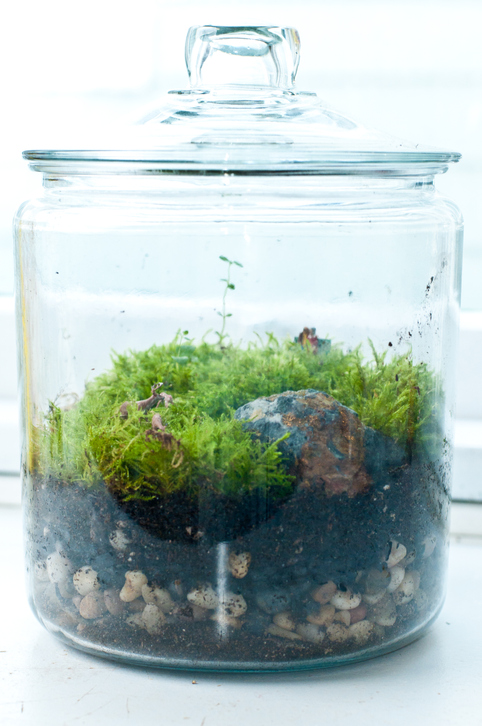
Odd, sure, but moss is a green miracle and quite mesmeric. You can find moss (or similar) at aquarium shops, then add gravel and stones and soil in a terrarium sort of container – but the lid does not have to be perfect, and huzzah! Your own Zen world. Once it gets going, it really is a matter of spraying with water and offering it a couple of hours of morning light. Very cool.
Orchids

So many to choose from! Dramatic, exquisite, statuesque – orchids are truly stunning if you are up for the challenge. Yes, this is supposed to be about really easy plants, but SOME people think an established orchid is just that. Again, light but not sun, proper orchid fertiliser, don’t spritz the blooms, but do take the time to learn all about them It’s worth it.
Which is the most beautiful indoor plant?
This will depend on what you value but for their beautiful flowers and trailing habit, it’s hard to go past the orchid family. Whether it’s the robust cymbidium varieties, the delicate moth or the stunning Sydney rock orchid, these stunning plants make a gorgeous display – and last a whole lot longer than cut flowers.
Which indoor plant purifies the air the most?
Since NASA published a study in 1989 on the effectiveness of indoor plants as air purifiers, there’s been discussion about which plants work best. Sadly, their ability to remove toxins has been overstated, but there are still plants that will benefit to your indoor air quality such the hardy Peace Lily, the Spider Plant, Mother-in-law’s Tongue and Devil’s Ivy.
Which indoor plant is the best for home?
This will depend on many factors, including how much time you spend at home, whether you have pets and how experienced you are at gardening but tough species such as Devil’s Ivy, Peace Lily, Rubber Plant and Monstera is a good place to start.
What is the easiest house plant to maintain?
All plants require some maintenance but more die from over watering than they do from too little care. Go for Peace Lilies, Spider Plants, Jade Plants and cacti for easy care, low maintenance plants.
This stylish family home combines a classic palette and finishes with a flexible floorplan
Just 55 minutes from Sydney, make this your creative getaway located in the majestic Hawkesbury region.
As Paris makes its final preparations for the Olympic games, its residents are busy with their own—packing their suitcases, confirming their reservations, and getting out of town.
Worried about the hordes of crowds and overall chaos the Olympics could bring, Parisians are fleeing the city in droves and inundating resort cities around the country. Hotels and holiday rentals in some of France’s most popular vacation destinations—from the French Riviera in the south to the beaches of Normandy in the north—say they are expecting massive crowds this year in advance of the Olympics. The games will run from July 26-Aug. 1.
“It’s already a major holiday season for us, and beyond that, we have the Olympics,” says Stéphane Personeni, general manager of the Lily of the Valley hotel in Saint Tropez. “People began booking early this year.”
Personeni’s hotel typically has no issues filling its rooms each summer—by May of each year, the luxury hotel typically finds itself completely booked out for the months of July and August. But this year, the 53-room hotel began filling up for summer reservations in February.
“We told our regular guests that everything—hotels, apartments, villas—are going to be hard to find this summer,” Personeni says. His neighbours around Saint Tropez say they’re similarly booked up.
As of March, the online marketplace Gens de Confiance (“Trusted People”), saw a 50% increase in reservations from Parisians seeking vacation rentals outside the capital during the Olympics.
Already, August is a popular vacation time for the French. With a minimum of five weeks of vacation mandated by law, many decide to take the entire month off, renting out villas in beachside destinations for longer periods.
But beyond the typical August travel, the Olympics are having a real impact, says Bertille Marchal, a spokesperson for Gens de Confiance.
“We’ve seen nearly three times more reservations for the dates of the Olympics than the following two weeks,” Marchal says. “The increase is definitely linked to the Olympic Games.”

Getty Images
According to the site, the most sought-out vacation destinations are Morbihan and Loire-Atlantique, a seaside region in the northwest; le Var, a coastal area within the southeast of France along the Côte d’Azur; and the island of Corsica in the Mediterranean.
Meanwhile, the Olympics haven’t necessarily been a boon to foreign tourism in the country. Many tourists who might have otherwise come to France are avoiding it this year in favour of other European capitals. In Paris, demand for stays at high-end hotels has collapsed, with bookings down 50% in July compared to last year, according to UMIH Prestige, which represents hotels charging at least €800 ($865) a night for rooms.
Earlier this year, high-end restaurants and concierges said the Olympics might even be an opportunity to score a hard-get-seat at the city’s fine dining.
In the Occitanie region in southwest France, the overall number of reservations this summer hasn’t changed much from last year, says Vincent Gare, president of the regional tourism committee there.
“But looking further at the numbers, we do see an increase in the clientele coming from the Paris region,” Gare told Le Figaro, noting that the increase in reservations has fallen directly on the dates of the Olympic games.
Michel Barré, a retiree living in Paris’s Le Marais neighbourhood, is one of those opting for the beach rather than the opening ceremony. In January, he booked a stay in Normandy for two weeks.
“Even though it’s a major European capital, Paris is still a small city—it’s a massive effort to host all of these events,” Barré says. “The Olympics are going to be a mess.”
More than anything, he just wants some calm after an event-filled summer in Paris, which just before the Olympics experienced the drama of a snap election called by Macron.
“It’s been a hectic summer here,” he says.

AFP via Getty Images
Parisians—Barré included—feel that the city, by over-catering to its tourists, is driving out many residents.
Parts of the Seine—usually one of the most popular summertime hangout spots —have been closed off for weeks as the city installs bleachers and Olympics signage. In certain neighbourhoods, residents will need to scan a QR code with police to access their own apartments. And from the Olympics to Sept. 8, Paris is nearly doubling the price of transit tickets from €2.15 to €4 per ride.
The city’s clear willingness to capitalise on its tourists has motivated some residents to do the same. In March, the number of active Airbnb listings in Paris reached an all-time high as hosts rushed to list their apartments. Listings grew 40% from the same time last year, according to the company.
With their regular clients taking off, Parisian restaurants and merchants are complaining that business is down.
“Are there any Parisians left in Paris?” Alaine Fontaine, president of the restaurant industry association, told the radio station Franceinfo on Sunday. “For the last three weeks, there haven’t been any here.”
Still, for all the talk of those leaving, there are plenty who have decided to stick around.
Jay Swanson, an American expat and YouTuber, can’t imagine leaving during the Olympics—he secured his tickets to see ping pong and volleyball last year. He’s also less concerned about the crowds and road closures than others, having just put together a series of videos explaining how to navigate Paris during the games.
“It’s been 100 years since the Games came to Paris; when else will we get a chance to host the world like this?” Swanson says. “So many Parisians are leaving and tourism is down, so not only will it be quiet but the only people left will be here for a party.”
This stylish family home combines a classic palette and finishes with a flexible floorplan
Just 55 minutes from Sydney, make this your creative getaway located in the majestic Hawkesbury region.
















